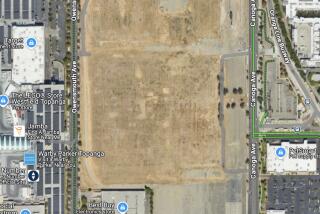No Desirable Options for Cleaning Underground Toxic Plume
- Share via
It stretches deep underground for 3 miles west from the El Toro Marine Corps Air Station, a toxic plume that could take decades to clean at a cost of many millions.
Now, military officials and regulators are grappling with just how much technology and money are needed to clean the ground-water contamination.
A new option now being studied, leaving the plume in place and carefully monitoring it while it is cleansed naturally, is triggering concern at the Orange County Water District. Officials there fear that an uncontrolled plume could in time move uncomfortably close to drinking-water wells 5 to 8 miles away.
The El Toro plume illustrates a dilemma surfacing at many toxic-waste sites nationwide in an era of shrunken government budgets and new thinking about how much high-tech science really should be focused on cleansing toxic ground water that does not directly threaten human health.
The plume of industrial solvent emanating from El Toro, for instance, is in water not currently used for drinking. But water district officials, who report the plume is expanding several feet a day, think that active cleanup is needed.
“We just think it’s wrong for the federal government to come and pollute and walk away without paying their fair share of cleanup,” said William R. Mills Jr., district general manager.
But, a Marine official countered Thursday, “we are every bit as committed now as we have been for many years to do the right thing to clean up the contamination,” said Wayne Lee, assistant chief of staff for environment and safety for western Marine Corps bases, including El Toro.
The military must scrutinize several alternatives and has not yet reached a decision, Lee said.
But he added: “We’re very sensitive to using every taxpayer dollar as efficiently as we can.”
Because of its widespread soil and ground-water contamination, the El Toro base is included on the federal Superfund list of the nation’s most hazardous waste sites.
To date, the federal government has spent more than $56 million for investigation and cleanup at the base, and it estimates another $166.4 million will would be need to complete studies and do cleanup.
The worst contamination is on the base itself, and the U.S. Environmental Protection Agency has asked the Navy to give priority to on-base cleanup and to prevent more pollutants from moving off the base grounds.
The plume of contamination that has traveled away from the base is 370 to 460 feet below the surface and is 50 to 1,000 feet thick, said Bonnie Arthur, El Toro project manager for the EPA.
The plume poses no health risk to the people living above it, Arthur said.
The Navy and local water districts have discussed co-financing a $34-million ground-water treatment plant in Irvine that would remove the solvent, known as trichloroethylene, as well as salts and nitrates derived from agricultural uses and other sources.
The Marines report, however, that they can only pay for cleaning those pollutants that came from the base.
And the water districts say they are alarmed by the latest list of cleanup alternatives under review by the Navy, which oversees the Marine Corps.
That list now includes an approach called “natural attenuation,” which typically involves containing ground-water contamination, monitoring it and allowing for biological degradation.
That approach would cost from $19 million to $39 million and take 54 to 70 years to clean the off-base contamination, according to the new study. Remaining on the list is the water treatment plant, which would clean the water in an estimated 49 years.
“This is all projection,” cautioned Arthur at EPA.
The military is not due to recommend a plan until late November, and a final decision is not expected until next year, Lee said.
Concern about the contamination was expressed Thursday at a meeting of the El Toro Citizens Advisory Commission, which ultimately will recommend a reuse plan for the base.
A hefty environmental impact report recommends building an international civilian airport at the base when the military abandons it by 1999.
On Thursday, the commission voted to extend the public comment period by three weeks until Oct. 15 to give the public more time to voice concerns about pollution, noise and traffic.
(BEGIN TEXT OF INFOBOX / INFOGRAPHIC)
Air Base Fallout
Plume of toxins are contaminating ground water.
More to Read
Sign up for Essential California
The most important California stories and recommendations in your inbox every morning.
You may occasionally receive promotional content from the Los Angeles Times.










